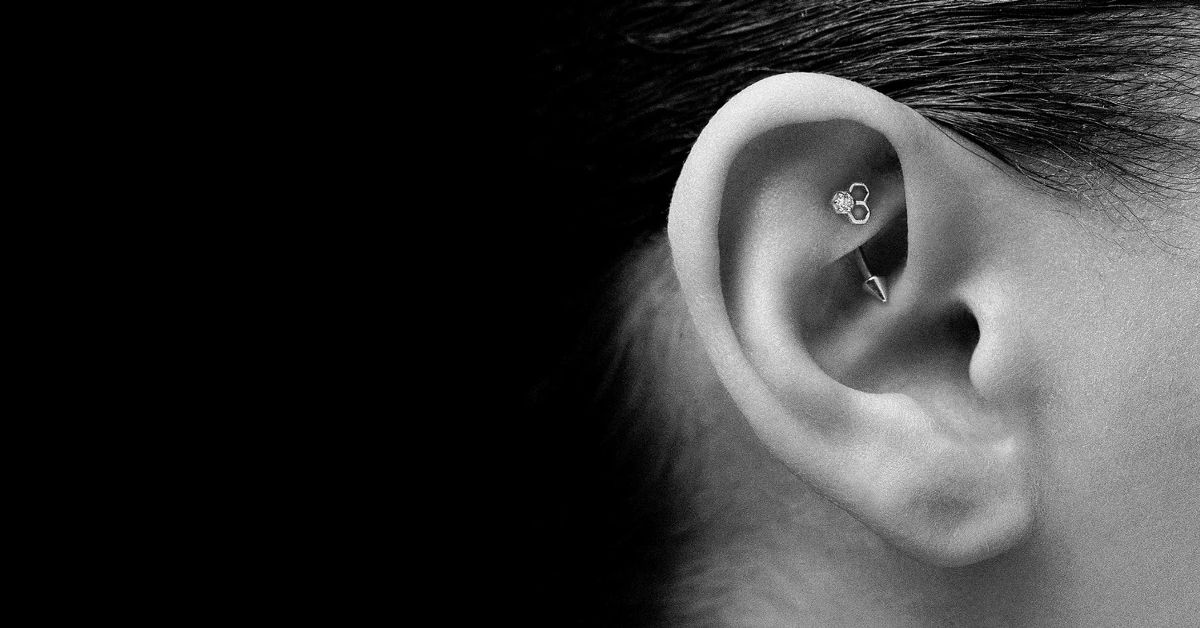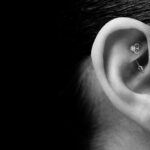For anyone typing “rook piercing” into a search bar, the underlying question is simple What exactly is it — and is it worth getting? A rook piercing is a perforation through the inner ridge of cartilage above the tragus, set deep in the ear’s antihelix. It’s discreet, architectural and increasingly common in piercing studios from Brooklyn to Los Angeles. But understanding its appeal requires more than a definition. The rook is small, but it carries a surprising collection of cultural, medical, aesthetic, and emotional layers.
Over the past several years, ear piercings have shifted from impulse purchases at mall kiosks to carefully considered procedures done in professional studios. Higher sterilization standards, jewelry engineering, and consumer awareness have pushed the industry toward something closer to a clinical craft. Amid that transformation, the rook piercing has emerged as a symbol of understated self-expression — a personal detail that whispers instead of shouts.
Its popularity also intersects with a broader social movement toward quiet individualism. A rook piercing tends to be visible only at certain angles or during close conversation. Many people choose it precisely for that intimacy. Yet the placement also raises important questions: healing difficulty, anatomical suitability, risk of irritation, and the necessity of choosing a skilled piercer.
This article explores those realities with the depth of a reported feature, combining expert voices, experiential insight, and contextual analysis. It looks beyond the trend cycles to examine how a small curve of cartilage became a touchpoint of modern body culture — and what anyone considering the piercing should know before making the leap.
Anatomy, Technique and Why Precision Matters
The rook piercing passes through a compact ridge of cartilage that curves sharply inward. Because the structure is small, even slight adjustments in angle determine whether the jewelry sits comfortably or places constant pressure on surrounding tissue. This is why experienced piercers emphasize anatomical assessment before committing to the procedure.
Cartilage has limited blood supply, which means it heals through diffusion rather than direct vascular support. In practice, this makes the rook more sensitive to friction and compression than fleshy piercings like the earlobe. Small errors — a post that’s too tight, jewelry that shifts under pressure, or a placement slightly off-center — can create prolonged swelling.
Precision also minimizes tissue trauma during the procedure itself. A clean, well-aligned puncture gives the body a straightforward pathway to repair. In contrast, a poorly angled needle can cause uneven tension, making irritation bumps or prolonged sensitivity more likely during healing.
Healing, Aftercare and the Shift Toward Minimal Intervention
Modern aftercare emphasizes restraint. Instead of rotating jewelry or applying ointments, today’s guidance focuses on keeping the area clean and untouched. Sterile saline solutions — not homemade mixtures — help reduce crusting without disturbing new tissue. The rook’s position complicates this because the ear naturally presses against pillows, headphones, or hats.
Many people adapt their sleeping habits by using travel pillows or specialized ear pillows, allowing the rook to rest in an opening instead of enduring nightly pressure. The healing process isn’t linear: the piercing may feel fully settled for weeks before suddenly becoming irritated again. These “flare-ups” are normal for cartilage.
Jewelry transitions happen slowly. Curved barbells are standard for fresh piercings because they allow space for swelling. Hoops or rings become viable only after the initial healing phase, usually several months in, once the tissue has begun to stabilize around the channel.
Comparative Healing Timelines for Ear Piercings
| Piercing Type | Initial Healing | Full Stabilization | Key Considerations |
| Earlobe | 6–8 weeks | 3–4 months | Faster due to soft tissue and blood flow |
| Helix | 3–6 months | 9–12 months | Sensitive to sleeping pressure |
| Rook | 4–6 months | 9–12+ months | Hidden placement makes pressure harder to avoid |
| Tragus | 3–9 months | ~12 months | Easily irritated by earbuds |
The Rook as a Cultural Marker and Fashion Detail
The rook piercing’s growing popularity reflects a subtle cultural shift. Instead of bold, highly visible body modifications, many people are opting for smaller pieces that hold personal meaning. Cultural anthropologists describe this trend as “private ornamentation,” where adornment is designed primarily for the wearer, not the audience.
The rook fits this category neatly. It’s visible only at certain angles or when someone brushes their hair back. Celebrities and fashion figures often wear them without fanfare, allowing the piercing to appear organically rather than as a headline accessory. Luxury jewelry brands now design miniature gem-set barbells and rings made specifically for this area, merging fine jewelry with body modification traditions.
The demographic range is striking. Teenagers, mid-career professionals, and older adults all choose the rook for different reasons: identity, aesthetics, reinvention, or quiet rebellion. Its appeal lies not in spectacle, but in nuance — a small architectural detail in the body’s natural framework.
Jewelry Options for Rook Piercings
| Material | Advantages | Considerations |
| Implant-grade titanium | Hypoallergenic, lightweight | Higher price than steel |
| Solid 14k/18k gold | Durable, luxurious appearance | Must be nickel-free to avoid reactions |
| Niobium | Biocompatible and stable | Less style variety |
| Surgical steel | Affordable, widely available | Not ideal for nickel-sensitive clients |
Industry Trends and the Economics Behind Precision Piercing
As consumers have become more discerning, piercing studios have evolved from casual shops into highly specialized spaces. Many now operate more like small medical practices, complete with sterilization logs, single-use tools, and strict contamination controls. This shift has raised both expectations and prices. A rook piercing that once cost under $40 may now exceed $90 before jewelry — but customers increasingly view the expense as part of a safety-first approach.
Jewelry manufacturers have responded to this demand by creating more anatomically sensitive designs. Micro-threaded barbells, internally threaded posts, and precision-cut gold pieces reflect the industry’s engineering progress. The complexity of the rook placement — with its tight angles and curved ridge — has accelerated these innovations.
Piercers also invest heavily in education, attending conferences, workshops, and cross-training sessions. The rook, once considered a specialty piercing, now serves as a marker of a studio’s technical skill and commitment to best practices.
Risks, Irritation and What Responsible Decision-Making Looks Like
Although generally safe when performed by a qualified piercer, rook piercings are more prone to irritation than simpler ear piercings. True infections are uncommon but possible. More frequently, clients encounter swelling, tenderness, or a temporary lump of inflamed tissue known as an irritation bump. These bumps usually result from pressure, friction, or touching.
Removing jewelry too early can trap bacteria inside the piercing channel, worsening symptoms. Instead, piercers often recommend adjusting habits — switching to over-ear headphones, sleeping on the opposite side, or using an ear pillow. People with autoimmune conditions, clotting disorders, or a history of keloids should consult a healthcare provider before committing.
The rook asks for patience. Healing rarely follows a straight timeline, and flare-ups months down the line don’t necessarily signal failure. What matters most is attentive, measured care and a willingness to seek professional guidance if discomfort escalates.
Key Takeaways
- The rook piercing requires skilled anatomical assessment and should not be attempted by inexperienced piercers.
- Healing takes many months and benefits from saline-only, hands-off aftercare.
- Implant-grade metals significantly reduce the chance of irritation or allergic response.
- Sleep position, headphones, and headwear play major roles in healing success.
- The rook’s growing popularity reflects a cultural move toward subtle, personal adornment.
- Complications are usually manageable when addressed early and calmly.
- A safe experience begins with a reputable studio that follows medical-grade protocols.
Conclusion
The rook piercing represents a convergence of aesthetics, anatomy, and contemporary culture. Its rise is not just a trend but part of a broader movement toward nuanced forms of self-expression — adornments that feel intimate rather than performative. The piercing’s discreet placement makes it uniquely personal, yet it also demands a thoughtful approach: choosing a trained piercer, selecting high-quality materials, and understanding that cartilage healing is a long, sometimes unpredictable process.
For many people, the rook becomes a small but meaningful reminder of autonomy or transition. For others, it marks a step into the world of curated ear styling, where piercings interact like architectural elements. Whatever the motivation, the rook invites deliberation. Its quiet presence underscores the relationship between body and identity without overwhelming either.
As piercing studios continue refining their practices and clients become more informed, the rook will likely remain a steady favorite — a subtle curve of metal tucked into the ear’s inner landscape, carrying more significance than its size suggests.
FAQs
1. Is a rook piercing very painful?
Most people describe the sensation as firm pressure rather than sharp pain. The experience is brief, though tenderness may persist for several days.
2. How long does a rook piercing take to fully heal?
Initial healing usually takes four to six months. Full stabilization often requires nine to twelve months, depending on lifestyle and anatomy.
3. Can anyone get a rook piercing?
No. Some ears lack a defined enough ridge for safe, comfortable placement. A qualified piercer will evaluate anatomy before proceeding.
4. What jewelry works best for a fresh rook piercing?
Implant-grade titanium curved barbells are widely recommended for initial healing. Gold or hoops are suitable only after the tissue has matured.
5. How can I tell if my rook is infected?
Persistent heat, worsening redness, thick discharge, or escalating pain may indicate infection. Seek evaluation from a piercer or medical professional promptly.







